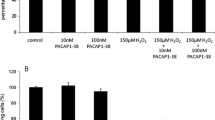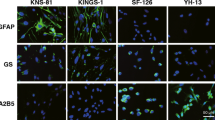Summary
The effect of dibutyryladenosine 3′,5′-cyclic monophosphate (dibutyryl cAMP) on the expression of glutathione S-transferase placental type (GST-P) was examined in rat glioma cell line using an immunohistochemical technique. Cultured T9 glioma cells were negative for GST-P activity under normal conditions. However, treatment with 1 mM dibutyryl cAMP produced GST-P expression in about 50% of the cells, as well as some morphological changes. The expression of GST-P was increased with addition of dibutyryl cAMP together with 1 μg/ml allyl isothiocyanate (AITC) or 0.1 μg/ml benzyl isothiocyanate (BITC). With these combinated treatments, almost all cultured cells showed a strong positive reaction for GST-P, although AITC or BITC alone elicited GST-P in only 5% of the cultured cells. The results of the present study indicate that dibutyryl cAMP causes functional as well as morphological differentiation of T9 glioma cells.
Similar content being viewed by others
References
Benda P, Someda K, Messer J, Sweet WH (1971) Morphological and immunochemical studies of rat glial tumors and clonal strains propagated in culture. J Neurosurg 34:310–323
Benson AM, Barretto PB (1985) Effects of disulfiram, diethyldithiocarbamate, bisethylxanthogen, and benzyl isothiocyanate on glutathione transferase activities in mouse organs. Cancer Res 45:4219–4223
Calissano P, Mercanti D, Levi A (1976) Ca2+, K+-regulated intramolecular crosslinking of S-100 Protein via disulfide bond formation. Eur J Biochem 71:45–52
Chasseaud LF (1979) The role of glutathione and glutathione S-transferases in the metabolism of chemical carcinogens and other electrophilic agents. Adv Cancer Res 29:175–274
Cole RA (1980) The use of porous polymers for the collection of plant volatiles. J Sci Food Agric 31:1242–1249
Denlinger RH, Axler DA, Koestner A, Liss L (1975) Tumorspecific transplantation immunity to intracerebral challenge with cells from a methylnitrosourea-induced brain tumor. J Med 6:249–259
Dunnick JK, Prejean JD, Haseman J, Thompson RB, Giles HD, McConnell EE (1982) Carcinogenesis bioassay of allyl isothiocyanate. Fund Appl Toxicol 2:114–120
Eder E, Neudecker T, Lutz D, Henschler D (1980) Mutagenic potential of allyl and allylic compounds. Biochem Pharmacol 29:993–998
Edstoem A, Kanje M, Walum E (1974) Effects of dibutyryl cyclic AMP and prostaglandin E1 on cultured human glioma cells. Exp Cell Res 85:217–223
Gil V, Macleod AJ (1980) Benzylglucosinolate degradation in Lepidium sativum: Effects of plant age and time of autolysis. Phytochemistry 19:1365–1368
Hynes LW, Weller RO (1978) Induction of some features of glial differentiation in primary cultured human gliomas by treatment with dibutyryl cyclic AMP. Br J Exp Pathol 59:259–276
Ioannou YM, Burka LT, Matthews HB (1984) Allyl isothiocyanate: comparative disposition in rats and mice. Toxicol Appl Pharmacol 75:173–181
Jakoby WB (1978) The glutathione S-transferases: a group of multifunctional detoxification proteins. Adv Enzymol 46:383–414
Kanno T, Nakazawa T, Kato Y (1972) Cyclic AMP and malignant glioma, Part 1. The effect of dibutyryl adenosine cyclic 3′,5′-monophosphate on glioma cells. Clin Neurol 12:584–595
Kjaer A (1960) Naturally derived isothiocyanates (mustard oils) and their parent glucosides. In: Zechmeister L (ed) Fortschritte der Chemie organischer Naturstoffe, vol 18. Springer, Wien, pp 122–176
MacIntyre EH, Wintersgill CJ, Perkins JP, Vatter AE (1972) The responses in culture of human tumor astrocytes and neuroblasts to N6,O2-dibutyryl adenosine 3′,5′-monophosphoric acid. J Cell Sci 11:639–667
Mani RS, Shelling JG, Sykes BD, Kay CM (1983) Spectral studies on the calcium binding properties of bovine brain S-100b protein. Biochemistry 22:1734–1740
Mani RS, Kay CM (1983) Isolation and spectral studies on the calcium binding properties of bovine brain S-100a protein. Biochemistry 22:3902–3907
Mannervik B (1985) The isoenzymes of glutathione transferase. Adv Enzymol 57:357–417
Mitchell J, Jordan W (1974) Allergic contact dermatitis from the radish Raphanus sativus. Br J Dermatol 91:183–189
Moore BW (1965) A soluble protein characteristic of the nervous system. Biochem Biophys Res Commun 19:739–744
Rowlatt C, Wicker R, Bernhard W (1973) Ultrastructural distribution of concanavalin A receptors on hamster embryo and adenovirus tumor cell cultures. Int J Cancer 11:314–326
Sato K, Kitahara A, Satoh K, Ishikawa T, Tatematsu M, Ito N (1984) The placental form of glutathione S-transferase as a new marker protein for preneoplasia in rat chemical hepatocarcinogenesis. Gann 75:199–202
Satoh K, Kitahara A, Soma Y, Inaba Y, Hatayama I, Sato K (1985) Purification, induction, and distribution of placental glutathione transferase: a new marker enzyme for preneoplastic cells in the rat chemical hepatocarcinogenesis. Proc Natl Acad Sci USA 82:3964–3968
Senjo M, Ishibashi T (1985) Specific localization of glutathione S-transferases in astrocytes and ependymal cells of rat brain: immunocytochemical demonstration. Biomed Res 6:433–436
Sparnins VL, Chuan J, Wattenberg LW (1982) Enhancement of glutathione S-transferase activity of the esophagus by phenols, lactone and benzyl isothiocyanate. Cancer Res 42:1205–1207
Sternberger LA, Hardy PH, Cuculis JJ, Meyer HG (1970) The unlabeled antibody enzyme method of immuno-histochemistry. Preparation and properties of soluble antigen-antibody complex (horseradish peroxidase-antihorseradish peroxidase) and its use in identification of spirochetes. J Histochem Cytochem 18:315–333
Tabuchi K, Furuta T, Norikane H, Tsuboi M, Moriya Y, Nishimoto A (1981) Evaluation of the drug induced morphological differentiation of rat glioma cells (C-6) from the aspects of S-100 protein level and con A binding pattern. J Neurol Sci 51:119–130
Tsuchida S, Izumi T, Shimizu T, Ishikawa T, Hatayama I, Satoh K, Sato K (1987) Purification of a new acidic glutathione S-transferase, GST-Yn1Yn1, with a high leukotriene-C4 synthase activity from rat brain. Eur J Biochem 170:159–164
Vos RME, Snoek MC, Bladeren PJ (1987) Differential induction of rat hepatic glutathione S-transferase isozymés by hexachlorobenzene and benzyl isothiocyanate. Biochem Pharmacol 37:1077–1982
Wattenberg LW (1981) Inhibition of carcinogen-induced neoplasia by sodium cyanate, tert-butyl isocyanate, and benzyl isothiocyanate administered subsequent to carcinogen exposure. Cancer Res 41:2991–2994
Wattenberg LW (1987) Inhibitory effects of benzyl isothiocyanate administered shortly before diethylnitrosamine or benzo(a)pyrene on pulmonary and forestomach neoplasia in A/J mice. Carcinogenesis 8:1971–1973
Author information
Authors and Affiliations
Rights and permissions
About this article
Cite this article
Hara, A., Sakai, N., Yamada, H. et al. Induction of glutathione S-transferase, placental type in T9 glioma cells by dibutyryladenosine 3′,5′-cyclic monophosphate and modification of its expression by naturally occurring isothiocyanates. Acta Neuropathol 79, 144–148 (1989). https://doi.org/10.1007/BF00294371
Received:
Revised:
Accepted:
Issue Date:
DOI: https://doi.org/10.1007/BF00294371




